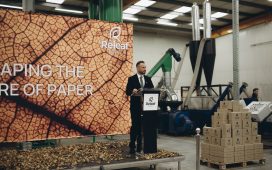
A familiar aroma wafted through the Believer Meats test kitchen earlier this year as Research and Development Chef Andres Voloschin flipped sizzling strips of chicken conjured from cells.
Through glass walls, he could see the large tanks where the cells grow.
Scientists, not farmers, produced this chicken. Some entrepreneurs, consumers and experts expect a lot more of the world’s meat to be made this way in the future.
___
EDITORS’ NOTE — This story is part of The Protein Problem, an AP series that examines the question: Can we feed this growing world without starving the planet? To see the full project, visit https://projects.apnews.com/features/2023/the-protein-problem/index.html
___
More than 150 startups are chasing an ambitious goal: meat that doesn’t require raising and killing animals that is affordable and tastes and feels like the meat we eat now. They are part of a young industry aiming to use cell biology to reduce the environmental impact of the world’s ever-increasing demand for meat and change global protein production the way electric cars are shaking up the auto industry.
“We are addicted to meat as a species. It’s part of our evolution. It’s part of our culture,” said Believer founder Yaakov Nahmias, whose country, Israel, is an industry hub along with California and Singapore. But “we thought about quantity rather than the environment, rather than sustainability.”
Companies making so-called “cultivated,” or “cultured” meat, which is also popularly known as “lab-grown” meat, are trying to scale up quickly — partnering with traditional meat companies, drawing more and more investors and breaking ground on new production facilities in the U.S. and elsewhere.
Wide adoption of meat from cells is nowhere near assured, however. This meat is expensive to make. There are scientific challenges, such as learning how to mimic the complex structure of steak. Government regulation is another obstacle. Only Singapore and the U.S. allow sales of cultivated meat.
And while many people who have tried it say they like it, others find the idea distaseful. An Associated Press-NORC poll found that half of adults in the meat-hungry U.S. would be unlikely to try it. A majority of those who said they wouldn’t said “it just sounds weird.”
Even Nahmias’ 10-year-old son Oren says he will only eat traditional meat. “I feel bad” for the animals, he said, “but they are yummy!”
HOW CELLS CAN BE TURNED INTO A CUTLET
The science behind this new meat comes from the medical world. Nahmias, a bioengineer, launched his company after going to lunch with a Tyson Foods executive at a conference and scribbling his method for making cultivated meat on a napkin.
Unlike traditional agriculture, this process starts with cells. Depending on the company, the cells may come from a piece of tissue, a fertilized egg or a cell “bank.” Various sorts can be used; scientists choose cells that can self-renew and turn into the muscle and fat cells that make up meat tissue. From starter cells they create “cell lines” so they don’t have to keep going back to animals.
These cells are placed inside vessels of various sizes called bioreactors and bathed in a nutrient-rich broth where they multiply. Thick, structured meat also requires a scaffold that helps cells organize into a shape. Changes in the composition of the broth, or media, and cues from the scaffolding, tell immature cells to turn into muscle, fat and connective tissue.
Once the bioreactor is full at Rehovot-based Believer, the paste of cells is harvested and mixed with plant proteins, then pressurized and pushed out to create meat fibers, Nahmias said.
Believer now makes cultivated chicken and lamb and has plans for beef, which is harder to make because it’s more difficult to create genetically-stable cell lines from bigger animals.
Other companies are pursuing cultivated beef anyway. It’s the focus of Believer’s Rehovot-based competitor Aleph Farms, where a scientist has scribbled a cow’s face on a piece of lab equipment. The cell line for their product started with a fertilized egg from a Black Angus cow named Lucy living on a California farm.
Producing meat this way could also dramatically reduce the impact of meat on the environment because it would reduce the need for land for the animals and for feed. Multiple studies show that traditional livestock production is responsible for about 10% to 20% of greenhouse gas emissions.
“The most important thing is that this field move forward and start reducing the destruction to our environment associated with current animal agriculture techniques,” said Glenn Gaudette, a biomedical engineering specialist at Boston College.
IT’S NOT SO EASY TO BUILD A STEAK
But transforming the ecosystem is a distant vision. At this point companies are still perfecting their products.
Scientists and industry experts say cultivated meats have a way to go before they’re indistinguishable from conventional meats, especially when it comes to the texture of products other than burgers or nuggets.
“When I get a steak, I want to see a steak,” said Jon Medved, CEO of the Israeli investing platform OurCrowd. “And we’re just not there yet.”
Price is also a problem. Production costs for the first cultivated beef burger, created a decade ago by Mark Post at Maastricht University in The Netherlands, were estimated to be in the hundreds of thousands of dollars. Now, the university says, the company he helped found, Mosa Meat, has reduced that to about $10 as it works toward commercialization.
For cultivated meat to take hold, such trends must continue, said Bruce Friedrich, president and founder of the Good Food Institute, a Washington, D.C.-based nonprofit advocacy group focused on plant-based and cultivated proteins. “If we don’t have products that taste the same or better and cost the same or less, people are not going to switch,” he said.
But there are vexing scientific hurdles. Gaudette said scientists are still trying to find the best scaffolds for structured meat, which must include a way for oxygen to get to all the cells. Options include animal-based scaffolds such as gelatin and, increasingly, decellularized vegetables like spinach. Gaudette said scientists are also working on challenges like getting the cells to adhere to scaffolds and align in the right way.
Cell food, the most expensive part of the cultivated meat process, presents different dilemmas. Some media includes expensive fetal bovine serum, which is derived from the blood of a cow fetus. Other types are serum-free but include costly ingredients. Startups are exploring less expensive non-animal alternatives, such as food-grade, rather than pharmaceutical-grade, “growth factors,” substances that stimulate cells to divide and grow in number.
Experts expect scientists to overcome the remaining scientific hurdles. But they say shaping human perception may be more difficult.
MEAT GROWN IN A LAB JUST SOUNDS STRANGE
Most people connect meat production with farms rather than science labs — which influences how they view these new products.
In the AP-NORC poll, just 18% of U.S. adults said they are extremely or very likely to try cultivated meat, and 30% said they are somewhat likely. Those under 45 years old are more likely than older adults to try it and men are more likely than women. When those unlikely to try it were asked to choose from a list of reasons why, half said they didn’t think it would be safe.
That’s a concern for respondent Nora Bailey, 31, a mother of three in rural Arkansas.
“I would obviously want to do more research as far as the long-term effects,” since early products deemed safe may later be found to be unsafe, she said.
A World Health Organization report noted several potential safety issues, such as microbial contamination at various points in the process, biological by-products and scaffolding that some people might be allergic to. Experts acknowledged a lot more safety testing is needed but noted that conventional meat carries significant food-safety risks, such as potential bacterial contamination during slaughter.
At this point, relatively few people have tried cultivated meat. But since its approval in the U.S. this summer, a small number of diners are eating it for the first time at particular restaurants and special events. People who recently tried cultivated chicken at U.S. company Good Meat’s headquarters in Alameda, California, said they liked it and would eat it again.
“When you bite into it, it was moist. It wasn’t dry. It did have that kind of feel of chicken, taste of chicken,” said Karen Hunt, who joined the taste test because she works nearby. “I was pleasantly surprised, and it tasted great.”
She said she’s not bothered by how it’s made, especially when she thinks about how traditional chicken is made. The cultivated meat process seems clean, controlled, environmentally safe and more humane, she said.
Kenzo Khoo, a nutritional science student at the University of California, Berkeley, said he would eat it regularly instead of traditional chicken if it became just as affordable.
“I would definitely buy it knowing that it will be more sustainable … because I think climate change is a really big problem,” he said after trying it. “I personally don’t taste any, like, difference.”
WHEN WILL CULTIVATED MEAT BE WIDELY AVAILABLE?
Experts say a lot more people will be trying cultivated meat soon. A recent report from the Good Food Institute found cultivated meat investments tripled on average each year from 2016 to 2022. About 70 traditional meat and food companies are involved with cultivated meat in some way. And regulatory approvals in the U.S. are expected to be followed by many more elsewhere.
With all of that pushing them forward, some cultivated meat companies are growing as fast as their cells. Good Meat has nearly completed a production facility in Singapore and plans a large-scale U.S. plant. Believer broke ground on its own large-scale plant last December in North Carolina.
Management consultant firm McKinsey & Company predicts cultivated meat could provide billions of pounds of the world’s meat supply by 2030. Still, that’s only around half a percent, and not nearly enough to offset rising consumption of meat from animals.
Though no one expects cultivated meat to transform human diets any time soon, some experts say population and climate pressures may make traditional meat production impossible in the long term — making cultivated meat a potential solution for a growing, fragile world.
_____
Associated Press video journalist Terry Chea contributed to this report.
___
The Associated Press Health and Science Department receives support from the Howard Hughes Medical Institute’s Science and Educational Media Group. The AP is solely responsible for all content.










